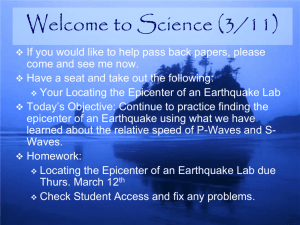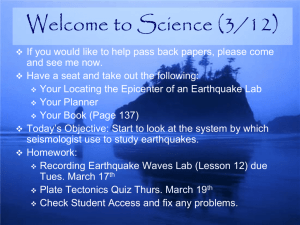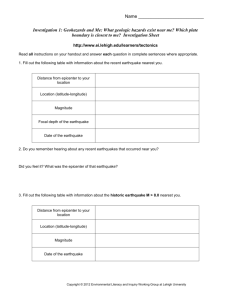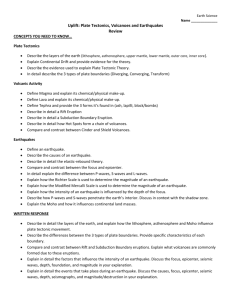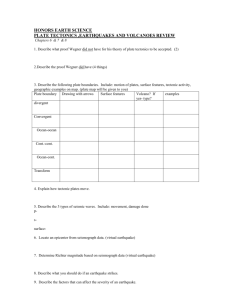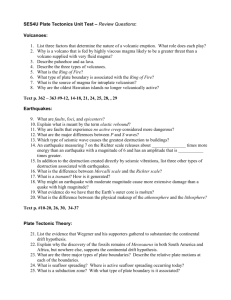dynamic earth unit_studyguide_key
advertisement
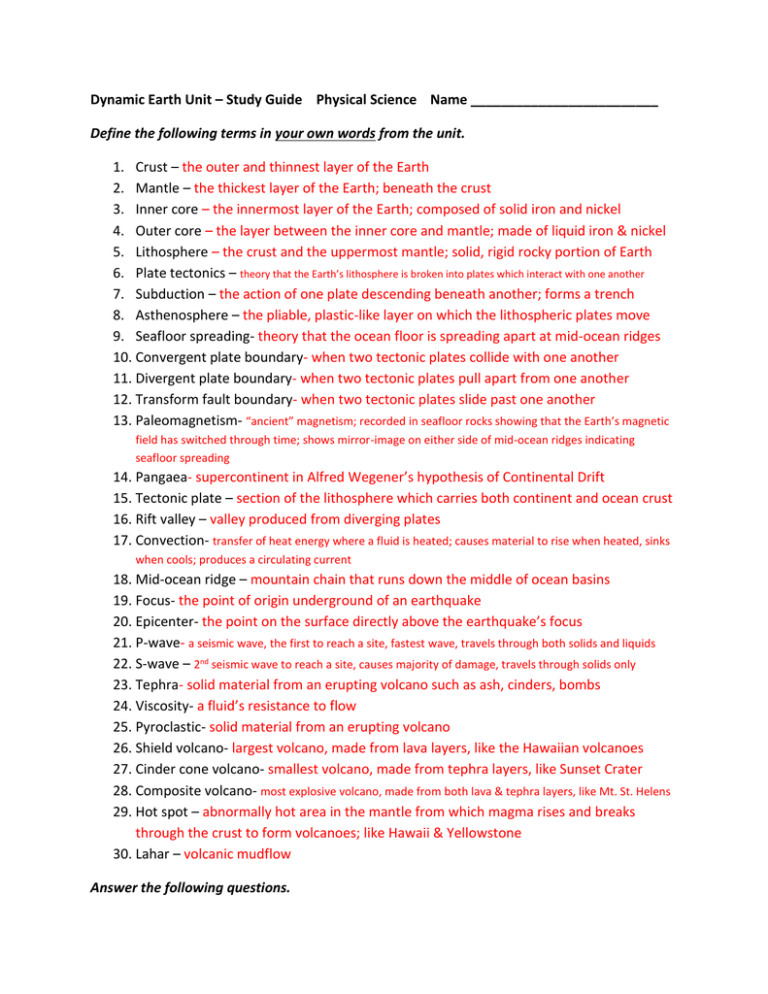
Dynamic Earth Unit – Study Guide Physical Science Name _________________________ Define the following terms in your own words from the unit. 1. Crust – the outer and thinnest layer of the Earth 2. Mantle – the thickest layer of the Earth; beneath the crust 3. Inner core – the innermost layer of the Earth; composed of solid iron and nickel 4. Outer core – the layer between the inner core and mantle; made of liquid iron & nickel 5. Lithosphere – the crust and the uppermost mantle; solid, rigid rocky portion of Earth 6. Plate tectonics – theory that the Earth’s lithosphere is broken into plates which interact with one another 7. Subduction – the action of one plate descending beneath another; forms a trench 8. Asthenosphere – the pliable, plastic-like layer on which the lithospheric plates move 9. Seafloor spreading- theory that the ocean floor is spreading apart at mid-ocean ridges 10. Convergent plate boundary- when two tectonic plates collide with one another 11. Divergent plate boundary- when two tectonic plates pull apart from one another 12. Transform fault boundary- when two tectonic plates slide past one another 13. Paleomagnetism- “ancient” magnetism; recorded in seafloor rocks showing that the Earth’s magnetic field has switched through time; shows mirror-image on either side of mid-ocean ridges indicating seafloor spreading 14. Pangaea- supercontinent in Alfred Wegener’s hypothesis of Continental Drift 15. Tectonic plate – section of the lithosphere which carries both continent and ocean crust 16. Rift valley – valley produced from diverging plates 17. Convection- transfer of heat energy where a fluid is heated; causes material to rise when heated, sinks when cools; produces a circulating current 18. Mid-ocean ridge – mountain chain that runs down the middle of ocean basins 19. Focus- the point of origin underground of an earthquake 20. Epicenter- the point on the surface directly above the earthquake’s focus 21. P-wave- a seismic wave, the first to reach a site, fastest wave, travels through both solids and liquids 22. S-wave – 2nd seismic wave to reach a site, causes majority of damage, travels through solids only 23. Tephra- solid material from an erupting volcano such as ash, cinders, bombs 24. Viscosity- a fluid’s resistance to flow 25. Pyroclastic- solid material from an erupting volcano 26. Shield volcano- largest volcano, made from lava layers, like the Hawaiian volcanoes 27. Cinder cone volcano- smallest volcano, made from tephra layers, like Sunset Crater 28. Composite volcano- most explosive volcano, made from both lava & tephra layers, like Mt. St. Helens 29. Hot spot – abnormally hot area in the mantle from which magma rises and breaks through the crust to form volcanoes; like Hawaii & Yellowstone 30. Lahar – volcanic mudflow Answer the following questions. 1. Who is credited with the hypothesis of Continental Drift? Alfred Wegener 2. Explain the concept of Continental Drift (not Plate Tectonics!). 200 million years ago, All the continents of the world were together as one supercontinent, called Pangaea, and separated/moved to their present-day locations 3. What evidence did this scientist show in favor of Continental Drift? Similar fossils, climate clues, mountain ranges, ore belts, glacial evidence on opposite continents 4. What was wrong with the idea of Continental Drift (why wasn’t it accepted)? Couldn’t show a mechanism for movement of the continents 5. Label the layers of the Earth’s interior below. A. B. C. D. Inner core Outer core Mantle crust 6. Who was the scientist who proposed the idea of seafloor spreading? Harry Hess 7. Explain how the age of the seafloor and paleomagnetism show that seafloor spreading occurs. The age of the seafloor and paleomagnetism show a mirror-image of themselves on either side of mid-ocean ridges, suggesting that the ocean floor is created there and destroyed in the trenches. 8. Which theory states that the Earth’s lithosphere is broken into large slabs or sections, called plates, which move and interact with one another? Plate tectonics 9. Label each of the three major types of plate boundaries below. A. Divergent B. Transform fault C. Convergent 10. What is the driving force for plate motion within the lithosphere? mantle convection Match the plate boundary type with the geologic structure it forms below. 11. Continent-continent divergent = rift valley 12. Continent-continent convergent = mountain range 13. Continent-ocean convergent=volcanic arc 14. Ocean-ocean convergent=island arc 15. Ocean-ocean divergent=rift valley (mid-ocean ridge) 16. Continent-continent transform=fault 17. Ocean-ocean transform=fault Geologic Structures Fault Volcanic arc Island arc Mountain range Rift valley 18. What is subduction?when one plate descends beneath another at a convergent boundary 19. What ocean floor feature forms as a result of subduction? Ocean trench 20. Explain the difference between the focus and epicenter of an earthquake. The focus is the origin/underground of an earthquake, the epicenter is point above the focus 21. Which nation suffered major damage and casualties from a 9.1 magnitude earthquake in 2011? Japan 22. What is a tsunami? A seismically-generated seawave which floods coastlines Using the P and S-wave Travel Time Graph above, answer the following questions. 23. How far can a P-wave travel in 7 minutes? 4000 km 24. How far can a S-wave travel in 10 minutes? 3000 km 25. A p-wave from a recent earthquake arrived at a seismograph station at 7:08 am. The swave from the same earthquake arrived at 7:14 am. How far away is the epicenter from this station? ~ 4000 km 26. If a seismic station is located 2000 km from the epicenter of a strong earthquake, how long after the p-wave arrives will it take for the s-wave to arrive? 3.3 minutes 27. How many seismograph stations is required to find the location of an epicenter? 3 28. Describe the process of locating the epicenter of an earthquake using circles and triangulation. Using the travel time curve, find the distance from epicenter of at least 3 locations. Draw circles using that distance as the radius from each city. Where the 3 cross is the epicenter. 29. What is the relationship between plate boundaries and earthquakes and volcanoes? Earthquakes and volcanoes occur mostly at plate boundaries. Match the volcano type to its attributes on the right. 30. Largest volcanoes = shield 31. Smallest volcanoes = cinder a. Composite 32. Most destructive = composite b. Shield 33. Hawaiian-type = shield c. Cinder cone 34. Olympus Mons, Mars = shield 35. Mt. St. Helens = composite 36. Sunset Crater, AZ = cinder 37. Made of layers of lava = shield 38. Made of layers of tephra = cinder 39. Made of layers of both lava & tephra = composite 40. Erupts mainly cinders, ash, & gases = cinder 41. Which three cities were used in triangulating the epicenter of this earthquake? Washington, DC, Oklahoma City, and Vancouver 42. Which city is where the epicenter of this earthquake is located? Denver 43. Which seismograph station received the first p-wave (of the three involved)? Oklahoma City 44. Which seismograph station (of the three) had the largest gap between p-wave and swave arrival time? Washington, DC
